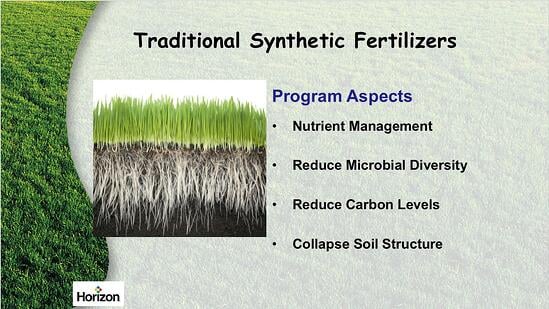Synthetic fertilizers can successfully deliver some nutrients to your customer's turf, but repeated use may also cause significant damage to the soil. In Part 13 of our Drought Solutions video series, you’ll see how synthetic fertilizers can affect carbon levels, destroy microbial activity, and ultimately lead to a complete soil collapse.
Video Transcript
Water management begins with carbon based natural fertilizers. Does everybody understand that statement? That means it's an organic fertilizer. Carbon based natural fertilizers.
Traditionally, stress is a result of synthetic fertilizers. High stress cause we're adding salts to that soil profile. The more salt we add, the harder it is for the plant to uptake that water because the salts are in the way blocking the nutrients.
You get rooting issues. We'll never get the density of this putting green using synthetics.
The one thing that golf course managers know is that organic fertilizers building their soil give them phenomenal density. Now the reason we'll never get as dense or we'll get the quality of a golf course is because we physically don't have the time to mow every one of our properties every day at 1/32". Density comes with frequent mowing at real tight, tight increments.
How Synthetic Fertilizers Affect the Soil Profile

In a synthetic fertilizer, you're going to get a little bit of nutrient management, but it's very little.
Synthetic fertilizers totally destroy your microbial activity in your soil. The microbes that are doing all of the work in a good soil profile get knocked out by salts. They just are not happy and you end up getting a soil collapse in the end.
And the reason is, is because your carbon levels in that soil profile are reduced. When you have reduced carbon levels, you have reduced bacterial activity because the carbon is what all the microbes feed on. That's their only energy source. And once you don't have any microbial activity and the carbon is gone, you get a complete soil structure collapse.
Soil structure collapse looks like that picture where the soil was all cracked earlier. There's virtually nothing there. It looks like that clay soil that was real muddy and soupy, where you don't have any nutrient flow throughout it. There's no airflow. That's a soil structure collapse.
A lot of the pictures that our water purveyors are showing now. Where that lake was all the way down to nothing and you get all that cracked soil and everything shrinking up. That's a soil collapse. Just because there's no nutrient load in it whatsoever.

